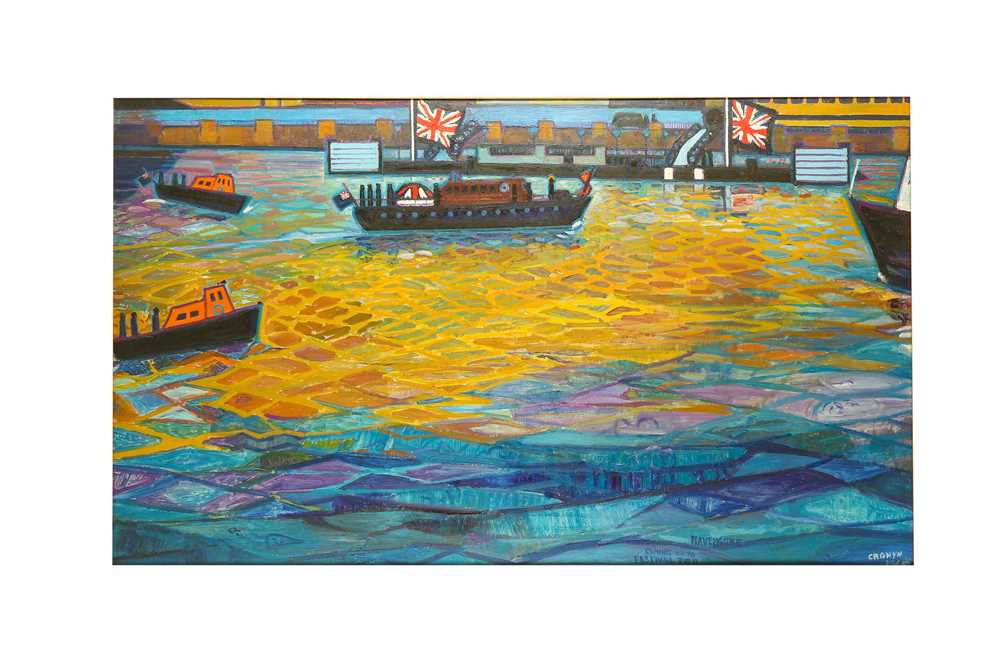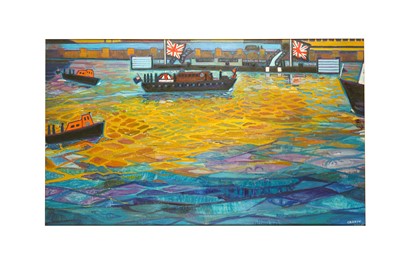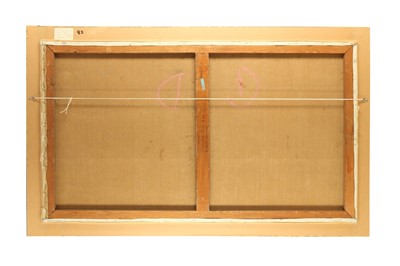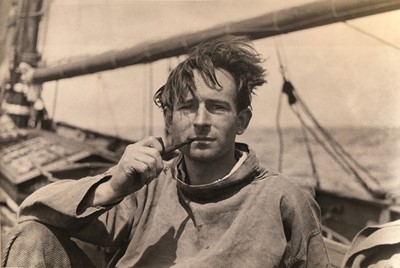22nd Apr, 2020 11:00
Modern & Post-War British Art
HUGH CRONYN (1905-1996)
PROPERTY FROM THE ESTATE OF HUGH CRONYN (LOTS 61-66)
HUGH CRONYN (1905-1996)
Churchill's Funeral Barge
signed and dated CRONYN/1965 (lower right), inscribed HAVENGORE/COMING UP TO FESTIVAL PIER (lower left)
oil on canvas
76.4 x (30 x 50 in)
PROVENANCE:
Artist's Estate
PROPERTY FROM THE ESTATE OF HUGH CRONYN (LOTS 61-66)
Photo caption:
Hugh Cronyn sailing across the Channel to Dunkirk in the late 1930s
Canadian-British painter Hugh Cronyn (1905-1996) led a fascinating life in America, Europe and England before the War, thanks both to the support and connection of his family and friends, and his innate charm and talent.
Young and impressionable, fresh from Vancouver, and with an irrepressible can-do New World outlook, Cronyn's unpublished memoires recount his study and travels and the many remarkable people whose paths he crossed: his beginnings as an artist in Toronto under Franz Johnston (an early member of the Group of Seven); his time at the Arts Students League in New York; his gilded years in Paris, 1930-34, tutored by André Lhote, when he travelled widely across Europe (whether struggling over the Alps by bicycle, or rescued from puncture failure by his cousin's chauffeur driven Bentley), and his subsequent immersion into the rich bohemian life he encountered in West London.
In Florence he was underwhelmed by his introduction to Roger Fry, but on his arrival in London was star struck by Ivon Hitchens, whose second solo exhibition at the Lefevre Gallery he helped hang. Living first in St Peter’s Square and thereafter in different studios on the Hammersmith-Chiswick borders by the Thames, he became acquainted with a swathe of leading artists and writers of the day, from Dylan Thomas to Henry Moore.
Most influential in his circle of friends was the humourist and politician A P Herbert ('APH' - 1890-1971) and his wife Gwendolyn. Pillars of the local community, they were regulars at the local Black Lion pub. At the lively gatherings and parties held at their home at 12 Hammersmith Terrace, Cronyn met such artists as Edward Wadsworth, Mark Gertler, Leon Underwood and John Piper. Ceri Richards lived nearby, as did poets Robert Graves and Laura Riding in St Peter’s Square. Cronyn became friends with Julian Trevelyan at Durham Wharf. On a trip to Dorset with Trevelyan he visited Eileen Agar at her farm, and was introduced to Kitty Church, wife of Anthony West, son of H.G. Wells (see lots 15-42). In his own studio he held sketching classes with Victor Pasmore, Claude Rogers and Elsie Few.
Following the outbreak of War, Cronyn was commissioned into the Royal Navy Volunteer Reserve. His distinguished war record began with the award of a George Medal (GM) when he defused a 500lb bomb that had lodged unexploded in the hold of an oil tanker. He subsequently served on board ship in the North Sea and the Pacific, ending his naval service with the rank of Lieutenant Commander. In 1942 he married Jean Harris (see lot 63), and from 1949-69 was tutor of painting at Colchester School of Art alongside John Nash who became a great friend. In 1975 the Cronyns moved back to Chiswick Mall to live at 3 St Peter’s Wharf overlooking the Thames, the artists’ studios recently constructed by his old friend Julian Trevelyan.
Cronyn exhibited widely during his lifetime, especially in London and Suffolk, including as a regular contributor to the Royal Academy Summer Exhibition, and in Toronto, Canada. His paintings are in private and public collections in France, Sweden the USA, Canada and the UK.
Painted in 1965, the present work depicts Havengore with Sir Winston Churchill’s coffin on deck, draped with the Union Jack on the day of his funeral: 30th January 1965. Following the service at St Paul’s Cathedral that morning, Havengore bore Churchill’s coffin from the Tower of London up the Thames to the Festival Pier. From there his body was taken by train to its final resting place at St Martin’s Church, Bladon, close to Blenheim Palace.
The first state funeral for a non-Royal for thirty years, at the time it was the largest and most watched event in history. Over 320,000 people queued to pay tribute whilst Churchill’s body lay in state in Westminster Hall for three days, 3,500 attended his funeral service at St Paul’s, and over 350 million tuned into the BBC to follow the occasion. During Havengore's journey up the Thames sixteen RAF fighter jets flew in formation over Churchills's coffin.
Cronyn was both a lifelong lover of the Thames and an ardent supporter of Churchill. A keen yachtsman, he had lived by the Thames in Hammersmith and Chiswick in the 1930s and 40s. In the War he had served in the Royal Navy with distinction, was awarded a George Medal and rose to the rank of Lieutenant Commander.
On the day of the funeral, Cronyn secured a spot on the Embankment on the north side of the river, from where he looked across to the floating pier on the South Bank, with the Royal Festival Hall to the right. In the ensuing oil Cronyn captures the stately arrival of Havengore at Festival Pier escorted by two bobbing pilot boats. Above, silhouetted against the blue hoardings hiding the construction site of Queen Elizabeth Hall, is the heavy black form of the hearse to take Churchill’s coffin to the waiting train at Waterloo Station.
Churchill’s widow, Lady Churchill memorably remarked to her youngest daughter at the end of what would surely have been an exhausting day for her: ‘It wasn’t a funeral, Mary – it was a triumph’, a note clearly borne out by the sense of celebration that Cronyn captures in the present vibrant depiction of this historic moment, despite the sobriety of the occasion.
Sold for £1,375
Includes Buyer's Premium
Do you have an item similar to the item above? If so please click the link below to submit a free online valuation request through our website.




